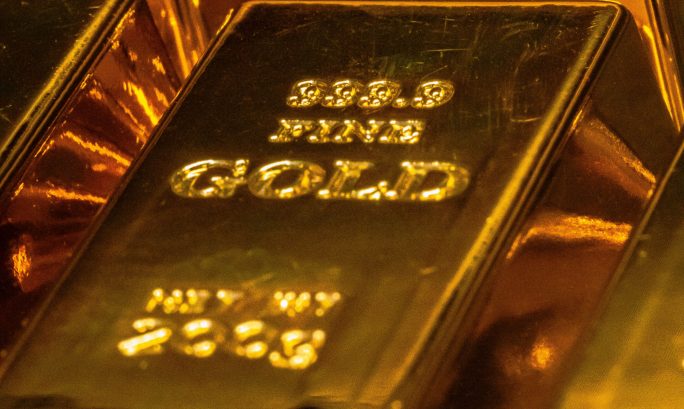Many investors want to invest in gold but think they must be ultra-rich to get started, but that’s not true. Read on to find out how to invest in gold.
As you will see, there are ways to invest in gold while earning an average income. Below are several possibilities to allow ordinary investors to get exposure to gold with small amounts of money.
Plus, you don’t have to be a “gold bug” or think we need to return to a gold-backed currency to consider investing in gold as a good idea. Gold investments are a legit way to diversify your portfolio and not completely rely on traditional options like S&P 500 stocks or owning rental properties.
Keep in mind these are investment ideas. You should still perform your own due diligence and only invest in products that match your investment goals.

Gold Royalty Stocks
Maybe you already invest in stocks and funds. These are usually well-established businesses with slow growth potential. Because the share price is relatively stable, dividend-focused investments offer a steady dividend payment.
Gold royalty stocks (sometimes called streaming companies) are similar to dividend stocks. The stock price is relatively stable with minimal upside potential but you earn consistent dividends.
Two of the largest royalty companies are Franco-Nevada (NYSE: FNV) and Wheaton Precious Metals (NYSE: WPM). These companies act as a bank and buy stakes in gold mining companies and other precious metals streams. Like a monthly interest payment, the royalty stocks collect payment from the mining companies. You earn a dividend for being a shareholder.
Royalty stocks don’t have as much potential upside as the junior miners that explore new mines. However, they are less risky because they invest in multiple miners which makes them a good long-term potential investment.
Pros
- Can earn regular dividend income
- Can be purchased from any online stock broker
- Stocks are highly liquid
Cons
- Don’t own physical gold
- The price of physical gold or shareholder expectations affects share prices
Gold ETFs
Gold bullion ETFs are similar to broad market index funds or buying ETFs that hold national currencies. These funds hold physical gold bars in vaults across the world. The ETF share price reflects the current gold price. For instance, if the price of gold rises 1%, the ETF share price has a similar change.
Two of the best-known gold bullion-backed ETFs are the SPDR Gold Shares (NYSE: GLD) and the iShares Gold Trust (NYSE: IAU). Neither fund pays a dividend but can be less volatile than royalty stocks. For example, royalty stocks have to keep securing new deals to maintain or increase their dividend payments. If shareholder expectations are not fulfilled, there can be a sharp sell-off.
Although you don’t own physical gold, it can still be cheaper and easier than buying physical gold. The downside is that these ETFs only let you own a paper stake in gold bullion. The trust owns the physical gold and won’t ship gold bars to your home or business.
You may decide to add gold ETFs and royalty stocks to your portfolio to invest in precious metals within your stock portfolio.
Pros
- Invest in physical gold bullion instead of mining companies
- Can be less volatile than investing in mining companies
- Shares can be easily traded with your current online stock brokerage
Cons
- No dividend payments
- All gold bullion is held in an off-site vault
Physical Gold Bars
If you want to own physical gold, you have several options including gold bars. These bars come in a variety of sizes. For instance, a one-ounce bar will cost the current market price plus a small premium.
If you don’t have enough cash to buy a single gold bar yet (approximately $1500 US dollars in October 2019), Vaulted lets you purchase physical gold with small contributions. Once your balance is enough to buy a physical bar, Vaulted will mail it to you via FedEx for a $50 shipping fee plus $2 per bar. Or, you can always keep your stake in Vaulted’s vault at the Royal Canadian Mint.
You will pay fewer fees by investing in gold ETFs. But if you want the option of exchanging your paper shares for actual gold, services like Vaulted can be worth paying a higher premium.
When buying physical gold, always check the purity level and transaction fees. Not all gold bars and gold sellers are the same. Gold bars should have a purity level of at least 99.5% and as high as 99.9%.
Pros
- Can own physical gold bars (not paper assets only)
- Can be less volatile than owning royalty or mining stocks
Cons
- More fees than owning a gold bullion ETF
- Harder to sell quickly if you need cash
Gold Coins
Another popular way to buy physical gold is owning gold coins. While you won’t be able to buy groceries or gasoline with gold (stores still only accept paper money or credit/debit cards), gold coins can be more valuable than gold bars. This is because rare coins have a collectible value like postage stamps, classic automobiles, or antiques.
A good example is U.S. quarter dollar coins minted in 1964 or before. You know, the ones with George Washington on the front and an eagle on the back. These coins contained silver through the 1964 production run. Starting in 1965, U.S. quarters no longer have silver but only a copper and steel alloy mixture. A quarter minted in either 1964 or 2019 is worth 25 cents if you buy something at a store. But a coin collector (numismatist) may pay you $3.29 to own the quarter with a 1964 mint year.
Gold coins are always worth at least the value of the gold composition. But some coins are worth more like the St. Gaudens $20 gold coin issued in the United States from 1907 until 1933. Although their face value is $20, an uncirculated coin can sell for as much as $12,000 US dollars.
Another popular gold coin is the South African Krugerrand. They can sell for more than the material value of the gold. However, less-popular gold coins may not appreciate in collectible value because there is a smaller demand.
If you buy gold coins, you may need to have them certified by a trustworthy appraiser. One of the most-trusted rare coin dealers in the United States is David Hall Rare Coins. If you’ve dabbled in gold collectibles you have probably heard of them or Van Simmons (their current president).
Pros
- Rare coins can have higher retail value than physical gold bars
- More likely to be accepted as legal tender
Cons
- Can sell at a higher premium than gold bars
- Less popular coins may not grow in collectible value
- Should verify a rare coin’s authenticity before buying
Gold Jewelry
Another way to indirectly invest in gold is by owning gold jewelry. Unfortunately, gold jewelry is also one of the most difficult ways to fairly assign value for the gold in the jewelry. To begin with, beauty is in the eye of the beholder. A trendy piece of jewelry may have a higher selling price now but might be difficult to sell when fashion styles change.
Like collectible coins, vintage jewelry can hold its value better than newer pieces that haven’t been time-tested yet. This is true even if it has a timeless design or produced by a legendary company.
You must also determine if the jewelry piece contains other precious metals or gems. If so, these elements can add to the value. The quality of the gold (10 karats vs 24 karats, for example) and other precious minerals is also a determining factor.
Pros
- A low-cost way to own physical gold
- Timeless pieces can be easier to sell than rare coins or gold bars
Cons
- Future prices can vary widely
- Less interest from collectors than bars or coins
What to Consider Before Investing in Gold
Below are a few things to consider before investing in gold. This is an alternative investment so you probably won’t want to sell your retirement account and go 100% gold.
Gold is another currency
By itself, gold is a currency like the US dollar, Euro, or British Sterling. In the last few years, you may even consider cryptocurrencies like Bitcoin as another paper currency alternative. It’s a way you can pay for a purchase or measure wealth.
But if you have $1,000 dollars to invest, you can’t earn passive income unless you put it in an interest-bearing bank account or invest it.
Owning gold is a hedge against depreciating currency values. If the value of the US dollar goes lower, the price of gold can increase if people value gold more. But if dollar-based assets increase in value, the gold prices can drop.
Physical Gold vs Paper Assets
Owning physical gold can cost more than only investing in gold bullion stocks. But you have the peace of mind of knowing you possess a tangible asset. You can physically verify the gold assets you own for authenticity.
With stock market investments, you may not actually own the gold. If the fund manager is dishonest, they may sell more shares than actual gold in their vault.
Value fluctuates
Gold’s historical price can fluctuate as paper currency values change. For example, gold’s all-time high was $1,896.50 US dollars in 2011. But it dropped to $1049.60 per ounce in 2015 before rising in value again.
Understand that your gold-backed investments can be worth less than the original purchase price and are not guaranteed to always make money.
Always take you investment goals and timeline into consideration. Like stocks, being able to own gold for many years means you are more likely to profit.
Summary
Investing in gold can be an easy way to diversify your investment portfolio. You may appreciate owning a tangible asset that has been an accepted measurement of wealth for much of history. Thanks to today’s digital investing tools, there are several ways to invest in gold in the 21st century.

